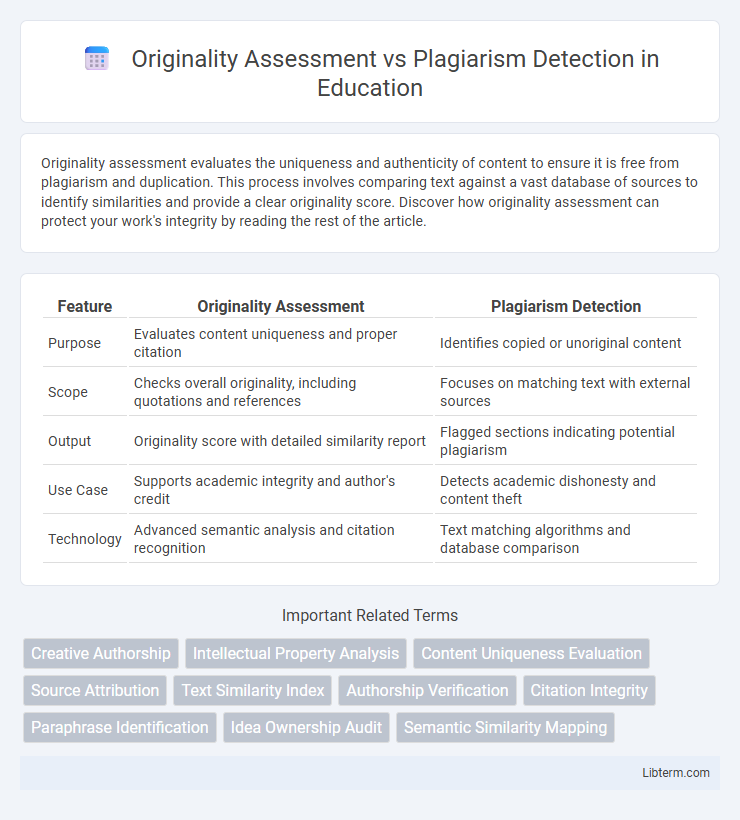Originality assessment evaluates the uniqueness and authenticity of content to ensure it is free from plagiarism and duplication. This process involves comparing text against a vast database of sources to identify similarities and provide a clear originality score. Discover how originality assessment can protect your work's integrity by reading the rest of the article.
Table of Comparison
| Feature | Originality Assessment | Plagiarism Detection |
|---|---|---|
| Purpose | Evaluates content uniqueness and proper citation | Identifies copied or unoriginal content |
| Scope | Checks overall originality, including quotations and references | Focuses on matching text with external sources |
| Output | Originality score with detailed similarity report | Flagged sections indicating potential plagiarism |
| Use Case | Supports academic integrity and author's credit | Detects academic dishonesty and content theft |
| Technology | Advanced semantic analysis and citation recognition | Text matching algorithms and database comparison |
Defining Originality Assessment
Originality assessment evaluates the uniqueness and authenticity of a work by comparing its content against a vast database of sources to ensure the ideas and expressions are genuinely created by the author. This process goes beyond simple text matching, analyzing paraphrasing, citations, and proper sourcing to maintain academic integrity. Plagiarism detection is a component of originality assessment but focuses specifically on identifying uncredited copying and direct matches in submitted content.
Understanding Plagiarism Detection
Plagiarism detection involves using advanced software algorithms to identify copied or improperly cited content within a text, ensuring academic and professional integrity. These tools scan databases, scholarly articles, and web content to detect similarities and provide a similarity index that helps users evaluate potential plagiarism. Understanding plagiarism detection requires recognizing its role in preventing intellectual property theft by highlighting verbatim matches and paraphrased content that lacks appropriate attribution.
Key Differences Between Originality and Plagiarism Concepts
Originality assessment evaluates the uniqueness and authenticity of a text by comparing it with existing sources to ensure new ideas or expressions are presented, while plagiarism detection specifically identifies instances of unauthorized copying or close paraphrasing without proper citation. Originality focuses on the creative contribution and proper attribution within academic or professional content, whereas plagiarism detection targets ethical violations related to intellectual property theft. Both processes use algorithms and databases but serve distinct purposes: originality fosters innovation and credibility, and plagiarism detection enforces academic integrity and legal compliance.
The Importance of Authentic Content
Authentic content is crucial for maintaining credibility, enhancing brand trust, and ensuring compliance with academic or professional standards. Originality assessment evaluates the uniqueness of ideas and expression, fostering genuine creativity and intellectual property protection. Plagiarism detection identifies copying or unintentional similarities, safeguarding against content misuse and preserving the integrity of published work.
Techniques for Assessing Originality
Techniques for assessing originality primarily involve semantic analysis, citation pattern recognition, and text similarity algorithms to evaluate the unique contribution of a work. Unlike simple plagiarism detection, which relies on matching text strings against databases, originality assessment uses contextual and conceptual frameworks to determine the novelty and integrity of ideas. Advanced methods incorporate machine learning and natural language processing to differentiate between common knowledge and innovative content in academic and professional writing.
Tools and Technologies for Plagiarism Detection
Plagiarism detection tools utilize advanced algorithms and machine learning to compare submitted texts against extensive databases, including academic papers, web content, and proprietary sources, ensuring comprehensive content verification. Technologies like Natural Language Processing (NLP) enhance the precision of detecting paraphrased or cleverly disguised plagiarism by analyzing semantic similarities rather than exact matches. Popular tools such as Turnitin, Grammarly, and Copyscape leverage these sophisticated technologies to provide real-time plagiarism reports with detailed similarity indices and source matching.
Challenges in Distinguishing Similarity from Plagiarism
Distinguishing similarity from plagiarism poses significant challenges due to the complexity of context, intent, and source attribution in Originality Assessment and Plagiarism Detection systems. High similarity scores may result from common phrases, technical terms, or proper citations, complicating accurate identification of genuine plagiarism. Advanced algorithms and human judgment are essential to differentiate between acceptable textual overlaps and unethical copying, ensuring fair and precise evaluations.
Best Practices for Maintaining Originality
Maintaining originality in academic and professional writing requires using both originality assessment and plagiarism detection tools to complement each other effectively. Originality assessment evaluates the uniqueness of content by analyzing writing style and structure, while plagiarism detection identifies direct matches with external sources, ensuring comprehensive content integrity. Best practices include proper citation, paraphrasing skills, and consistent use of software like Turnitin or Grammarly combined with manual review to uphold high standards of intellectual honesty.
Ethical Implications in Academic and Professional Fields
Originality assessment and plagiarism detection play crucial roles in upholding ethical standards in academic and professional fields by ensuring the authenticity and integrity of submitted work. While plagiarism detection tools identify copied content, originality assessment evaluates the uniqueness and proper sourcing, fostering responsible scholarship and trustworthiness. Implementing these technologies promotes fairness and accountability, protecting intellectual property rights and maintaining the credibility of institutions and professionals.
Future Trends in Originality and Plagiarism Detection
Future trends in originality assessment and plagiarism detection emphasize the integration of advanced AI algorithms capable of contextual understanding and semantic analysis, improving accuracy beyond simple text matching. Emerging technologies leverage machine learning to detect paraphrased content, cross-language plagiarism, and even code plagiarism, enhancing the scope of digital content verification. Continued development in natural language processing and large language models promises more robust, real-time originality evaluation tools tailored for academic, creative, and professional sectors.
Originality Assessment Infographic

 libterm.com
libterm.com